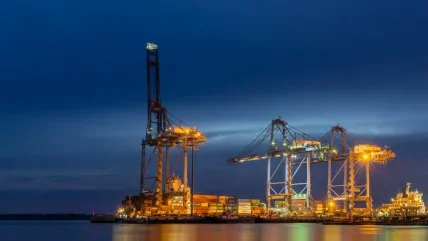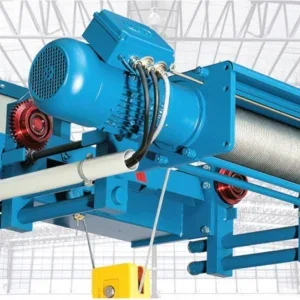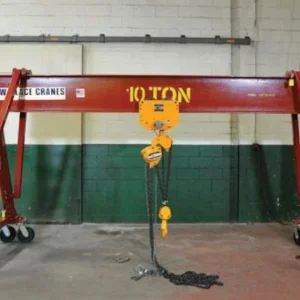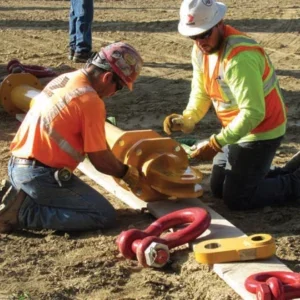
Imaginative initiatives will drive the Port of Long Beach’s goal to become the world’s first zero-emissions seaport, executive director Mario Cordero announced during the first in-person State of the Port address following two years of virtual events due to Covid.
Cordero committed to supporting state and federal efforts to increase renewable energy sources as he declared 2023 as the “Year of Imagination”.
Among the projects planned, was the port’s bid to assemble and manufacture offshore wind turbines that will increase the state’s supply of renewable energy and reduce greenhouse gas emissions.
Citing the port’s track record of investments to improve air quality and natural harbour habitat, Cordero called on companies with strong environmental policies to choose the Port of Long Beach when shipping their goods and materials.
“I am proud to be part of an industry and a port that together offer innovative approaches and forward-thinking initiatives that continue to be the most imaginative solutions in the nation,” Cordero told 750 industry partners, community members and civic leaders gathered at the Long Beach Convention Center Grand Ballroom for the State of the Port address.
“This [port] has plenty of work ahead. However, let there be no doubt: the Port of Long Beach is leading the way.”
Building on nearly two decades of green initiatives, the port is establishing a Zero Emissions, Energy Resilient Operations Program – known as Zeero – to invest in projects aimed at reducing the impacts of operations and improving air quality.
Among its goals, Zeero supports the development of renewable energy projects, including the port’s proposed floating offshore wind staging and integration facility, known as Pier Wind.
A conceptual assessment was scheduled for completion in the spring for Pier Wind, which aims to become the largest facility specifically designed to accommodate the assembly of offshore wind turbines at any US seaport.
Turbines assembled in Long Beach would be deployed to wind farms off the coast of Central and Northern California. The project would help California meet a goal of producing 25GW of offshore wind power by 2045, in addition to creating jobs and economic opportunities for communities near the San Pedro Bay port complex.
The port ended 2022 with 9,133,657 twenty-foot equivalent units (TEUs) moved, down 2.7% from 2021, which remains the port’s most active year in its 112-year history. With more than 1.4 million TEUs of loaded exports moved, the port remained the nation’s leading export port for a second consecutive year. Easing into the second-busiest year on record allowed the port to return to normal operations by the end of 2022.
“I look forward to strong partnerships on how we can imagine our port [becoming] even greener, stronger and more engaged in our communities,” Long Beach Harbor Commission president Sharon L. Weissman said at the event. “Let’s have the courage to pursue together a zero-emissions port that provides the best goods movement and service in the world.”
Over the next decade, the port plans to invest in rail improvements that will improve efficiency, reduce truck trips and lessen environmental impacts amid increases in cargo.
Key projects completed in 2022 include the Pier G-J Double Track project, providing an extra track for rail arrivals and departures in the south basin area. Additionally, construction started on the Fourth Track at Ocean Boulevard project, adding another rail line to the port. Construction begins in 2024 on the rail programme centrepiece, the Pier B On-Dock Rail Support Facility, which will allow longer trains to be created more frequently.
Another significant milestone was achieved in 2022, when President Joe Biden authorised the Army Corps of Engineers to proceed with planned channel deepening. The project will allow some of the largest shipping vessels to more easily transit Port of Long Beach waters, improving efficiency and the environment.
The Port of Long Beach is one of the world’s premier seaports, a gateway for trans-Pacific trade. It handles trade valued at more than $200bn annually and is said to support 2.6 million trade-related jobs across the nation, including 575,000 in Southern California.
COLD STORAGE
The Georgia Ports Authority (GPA) is increasing chilled cargo capacity to stay ahead of anticipated growth in demand.
“Expansion among our cold storage partners in the Savannah market will drive greater volumes of chilled cargo crossing our docks,” said Griff Lynch, executive director, GPA. “While the Port of Savannah already accommodates the most refrigerated containers on the South Atlantic and Gulf coasts, enhancing our on-terminal capacity will better support the jobs and opportunity sparked by private investment.”
Private chilled and frozen warehouse space in Savannah is set to grow by 11% in 2023 to more than 2.2 million square feet.
At a meeting, the GPA board approved construction of seven additional refrigerated container racks at the Port of Savannah. The $6.2m project will grow the number of slots for cold cargo to 3,506 at Garden City Terminal, counting chassis plug-ins. Savannah’s Ocean Terminal provides another 368 refrigerated container plugs.
Chilled and frozen products handled at the Port of Savannah range from proteins such as poultry and seafood to blueberries, avocados, citrus, stone fruits and onions, among other commodities. GPA’s fastestgrowing cold chain exports in 2022 were poultry, beef, fish fillets, candy and frozen vegetables. Top-performing chilled imports were grapes, vegetables, fish fillets, potatoes and candy.
“Serving the US Southeast via Savannah reduces overland transportation costs to vital markets such as Atlanta, and ensures perishable goods reach customers faster and fresher,” said Joel Wooten, board chairman, GPA. “The growing population of our region, combined with expansions in port and private infrastructure, are strengthening Savannah’s position as a perishable supply chain gateway.”
In other business at the GPA board meeting, Lynch reported that vessel service had returned to normal operations, with no backlog.
Additionally, Lynch reported that four new ship-to-shore cranes arrived at the Port of Savannah in February. The cranes are large enough to handle vessels with a capacity of 20,000-plus TEUs.
The cranes are destined for Container Berth 1 at Garden City Terminal, which is currently under renovation. When berth improvements are complete in July, the Port of Savannah will be able to serve seven ships simultaneously.
ACQUISITION
Logistec Stevedoring, a subsidiary of Logistec Corporation, a North American marine and environmental services provider, has entered into a definitive agreement to acquire the Canadian and US marine terminal business of Fednav, including Federal Marine Terminals and the logistics division, Fednav Direct (FMT), for $105m.
The transaction will allow Logistec to strengthen its presence in Canada and the US and add specialised expertise to its service offering.
FMT has operated terminal facilities at ports in Canada and the US for over five decades. Recognised as an industry leader in marine terminal operations, it provides stevedoring, handling and warehousing services for bulk, containerised, project cargo, and general cargo. FMT also offers value-added on-carriage services, inventory management, and 24/7 inland cargo transportation in both countries.
For the year ended 31 December 2022, FMT generated revenue of $89.8m (approximately CA$116.8m) with gross margins comparable to Logistec’s marine segment.
The addition of 11 terminals represents a major expansion of Logistec’s network, bringing its total to 90 terminals in 60 ports across North America. The combined network will provide strategic gateways for existing and future customers, allowing Logistec to gain a foothold in the Great Lakes region and access prime locations in the US Gulf and East Coast regions.
“We are delighted to welcome FMT to continue to grow together across Canada and the US,” said Madeleine Paquin, president and CEO Logistec.
“Logistec and FMT have had a longstanding business relationship for decades and joining forces is a natural fit, as we share the same values. The combined capabilities and expertise of both organisations will create solid synergies to deliver operational excellence to marine shippers across North America.”
Paul Pathy, CEO and president, Fednav, said Logistec, a company with cargo handling as its core business, will ensure FMT’s ongoing success and growth, and in the coming years Fednav will focus on its pure-play shipping business and continue its expansion journey with an exciting new chapter ahead.
“As part of Logistec’s ambitious strategic plan to expand its marine services both geographically and operationally, this acquisition will allow us to gain a footprint in new markets in Canada and the US,” added Rodney Corrigan, president Logistec Stevedoring. “Our customers will benefit from a large and efficient network, as well as strong expertise from the FMT team, and together, we will continue to offer quality service to contribute to a safe, reliable supply chain.”
POST-PANAMAX CRANES
DP World and Port Saint John in Canada have welcomed two post-Panamax cranes to the container terminal.
The arrival of the cranes marks a significant milestone in Port Saint John’s $205m modernisation project – a three-way partnership between the Government of Canada, the Province of New Brunswick and Port Saint John. These additional cranes bring the total to four, the most quay cranes ever at Port Saint John.
The cranes arrived from Charleston, South Carolina, and are the bigger brothers to the two cranes that arrived in 2016. The Hyundai Heavy Industries Container Cranes have an outreach of 19ft, can reach up to 21 containers wide and are capable of servicing vessels with a capacity between 10,000 and 14,000 TEUs.
The wider modernisation of the port, due for completion this year, will mean economic benefits for Saint John and the New Brunswick province as a whole, through more career opportunities at the port and in the transportation, logistics and warehousing sectors.
Craig Bell Estabrooks, president/CEO, Port Saint John, said the arrival of the two cranes is symbolic of its growth.
“Soon we will have more than double the capacity to move product and to create jobs. Partners like DP World open doors for us and our local economy to pursue new opportunities for our industrial parks, our supply chain and manufacturing capacity. With every new milestone we hit, we solidify our position as one of Canada’s top ports and we intensify our standing as an agent for positive change and economic growth for our province,” he added.
MOBILE HARBOUR CRANES
Konecranes has partnered with two port operating companies in Guyana – Muneshwers and John Fernandes – on a joint order for two Generation 6 Konecranes Gottwald Mobile Harbor Cranes to build up cargo handling terminals in the capital Georgetown.
When the cranes arrive in Q2 2023 they will be the very first mobile harbour cranes in Guyana, and Konecranes Gottwald Mobile Harbor Cranes will be present in all the coastal states of South America.
John Fernandes and Muneshwers are working together to build a regional cargo hub for the common good of Guyana. They have purchased the cranes to handle ‘gearless’ ships – that is, ships that do not have their own onboard loading/ unloading equipment.
This will be a first for Guyana, making the Port of Georgetown able to receive a much wider variety of cargo ships that can also be much larger. The cranes will have the latest technology to maximise productivity, with the flexibility to handle both containers and general cargo on the quay while minimising fuel consumption and carbon emissions.
“As we planned our hub, it soon became clear that the right equipment for us was mobile harbour cranes, and we made site visits to Jamaica and Florida where we could see cranes of different brands in action at customer sites,” said Robin Muneshwer, CEO, Muneshwers.
“Konecranes Gottwald Mobile Harbor Cranes impressed us with their performance, reliability, and robustness as well as their outstanding ecoefficiency. Their special hybrid drive offers us both performance peaks in fast and heavy cargo handling and fuel-saving options,” added Philip Fernandes, CEO of John Fernandes.
The cranes have a working radius of 49m and a capacity of 125t to serve container ships up to Panamax class. They will be used for container handling mainly, but their flexibility allows them to handle general cargo when needed.
The cranes use Konecranes hybrid drive, which consists of a modern diesel engine paired with an ultracapacitor that can be recharged by energy recovered from lowering and braking motions. This is said to give the power needed for peak performance, while saving fuel when moving lighter loads.
“We’re proud that John Fernandes and Muneshwers have chosen Konecranes to provide the first mobile harbour cranes in Guyana. It’s a true milestone in the development of professional cargo handling for both Guyana and Konecranes,” said Andreas Moeller, senior sales manager, Americas, Port Solutions, Konecranes.






